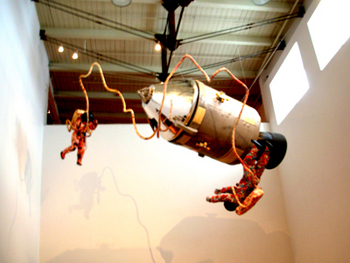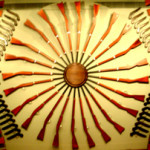The sprawling complex of galleries, a cluster of connected industrial buildings of the former Sprague Electric Company in North Adams, Mass. may be described as the visual equivalent of a three ring circus. Currently, the largest space of Mass MoCA contains a vintage, ersatz amusement park by Carsten Holler, which is actually not that amusing. A second grouping of galleries comprises a one person show of the Chinese born and Paris based artist, Huang Yong Ping. It happens to be one of the most staggering and insightful exhibitions of contemporary art on view anywhere in the United States, or the world for that matter, at the moment. Rounding out this visual circus, in the small ring so to speak, is a group exhibition “Ahistoric Occasion: Artists Making History,” on view through March, 2007, organized by the museum’s curator Nato Thompson, that is, to be quite honest, a bit of a chin scratcher and head thumper.
Once again the curator has assembled a provocative group show based on an esoteric theme that combines a couple of high profile, centerpiece artists- Yinka Shonibare and Kerry James Marshall- the lively emerging artists- Paul Chan and Peggy Diggs- and several previously unknown artists- Felix Gmelin, Trevor Paglen, Dario Robleto, Nebojsa Seric-Shoba and Allison Smith.
Thompson (Nato the curator, not be confused with Joe, the director) must be real smart. If not smart alec or smarty pants. Which means that you have to do a bit of homework to figure out just what this exhibition is really all about. The era of just looking at work and reading a few wall texts to figure out contemporary exhibitions has kinda lapsed. In a relatively brief essay about the eleven artists on view the curator has quoted or cited a dizzy array of sources: Walter Benjamin, Francis Fukuyama, T.J.Clark, Karl Marx, Georg Wilhelm Friedrich Hegel, Francois Lyotard, Jean Baudrillard, Theador Adorno, Frederick Jameson, Dr. Frankenstein, Arthur Rimbaud, Michael Hardi and Antonio Negri, and Mike Davis. Like many young curators Nato should graduate from graduate school. There is, after all, a substantial difference between a thesis and an exhibition. Or, to add yet another quote to an already pedantic essay, as Duke Ellington said “It don’t mean a thing if it ain’t got that swing.” Why is it that young curators just don’t have any natural rhythm?
Yeah, I get it, and I’m sure you will too. This is all about artists deconstructuing history. Revisionism as cutting edge and stuff. There are some compelling works but it is just too daunting and hard work to connect all the dots. Or, at least as Nato sees them. Some of the work is pretty esoteric particularly for tourists exploring the Berkshires. The Norman Rockwell Museum this is not.
The pride of place and centerpiece of the exhibition is devoted to an enormous tall gallery, narrow and wide, displaying works by the British artist, Yinka Shinobare. Not that we haven’t seen this work just about everywhere from Brooklyn, to London, Vienna, and Kassel. But, yes, a first for North Adams. A real coup. I guess. From the ceiling is suspended “Space Walk” from 2002 which features floating male and female astronauts. The press release informs that their space suits are covered with colorful Afro-Pop icons of African Americans including Martin Luther King, James Brown and Billy Holiday. The figures are so far away that this detail is lost to the naked eye. But it is hard to miss the large screen video projection of an elaborately costumed, 18th century dance “Un Ballo in Marcheran.” While it animates the artist’s customary Post Colonial mannequin sculptures with real people it is not very compelling either as dance or video art. Arguably, this is an afterthought for the artist who made his mark in other media.
A grid of “19 Lincolns” by Greta Pratt is little more than a visual one liner. Hey, one Lincoln looks much like another. Why not the Flying Elvises? In very small hand, vintage 18th century script, Allison Smith has penned a text “Public Address” that surely not one in a million visitors will take the time and trouble to read. It has something to do with a ceremonial cluster of arms on an adjoining wall.
Reenactment of one kind or another is a major theme of this exhibition. Such as Jeremy Deller’s “The Battle of Orgreave” which restages a conflict between strikers and cops that occurred in 1984 in Sheffield, England. With all of its elaborate detail and talking head interviews with participants it is difficult to understand just why this is “art” when its normal context would be a PBS documentary or episode of Frontline. There is a sinilar feeling to the reenactment, on two monitors, by Felix Gmelin, of vintage footage from 1968 when the artist’s father and other students ran a relay through Berlin grasping the red flag of communism. What was a charged political statement during that era of protest and activism seems flat and inert in the reenactment. Which is precisely the point making this work provocative and successful.
It was stunning and spectacular to view the video “Happiness (finally) after 35,000 years of civilization-after Henry Darger and Charles Fourier.” Darger was the outsider artist who left behind a legacy of panoramas of androgynous often naked boys and girls playing toy soldiers engaging in mock combat and doing rather naughty things. This video is not for children despite its childlike “innocence.”
(“Henry Darger-born 1892 in Germany or Brazil- died in 1973 in a Catholic mission operated by the Little Sisters of the Poor. He had no family or friends. Neighbors in his North Chicago apartment building remembered him as an unkempt man who scavenged through garbage cans and talked to himself in numerous voices. He often attended mass several times a day. Secretly Darger had been creating a massive body of work since 1909. If Darger's landlord, photographer Nathan Lerner, had not sorted through the apartment after he moved to the mission, the writings and paintings would have been lost. Central to Darger's work is his 15,000 page, 12 volume, single-spaced, typewritten epic entitled The Story of the Vivian Girls, in What is Known as the Realms of the Unreal, of the Glandeco-Angelinnian War Storm, as caused by the Child Slave Rebellion.”)
Darger was a lot like Lewis Carroll only more so. Alice as a little strumpet. This is very different work than Chan’s shadow pieces and oblique projections featured this season at Boston’s Institute of Contemporary Art and in the Whitney Biennial. The “Darger” is a truly riveting and galvanic video. Wow.
Finally, we applaud Peggy Diggs for the clever and insightful manner in which she expanded her work with a collection of jars and objects at Mass MoCA to a second, more interesting project, off campus, in a small storefront on downtown Eagle Street. In an installation called “Here and Then” Diggs, a Williamstown resident, gathered a number of snap shots and vintage images of sites and landmarks around North Adams. These are attached to a maze of hanging mesh that visitors are invited to walk through. There are blank tags that local viewers are encouraged to write on and attach to the mesh hangings with their own memories and experiences. For the first time the artist has succeeded in breaking down the problematic “town vs. gown” elitism and isolation of Mass MoCA.
And yes, Nato, thanks for the history lesson. I learned a lot. But, hey, school’s out and girls just wannah have fun.
Links:
MassMoCA
"Ahistoric Occasion: Artists Making History" is on view through March 2007 at Mass MoCA.
All images are courtesy of the artist, Mass MoCA and the author.







